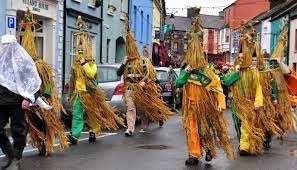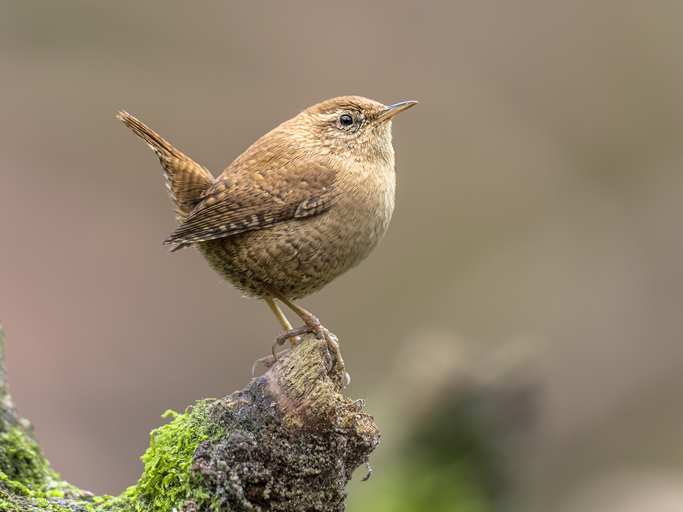



While many countries view 26 December as ‘Boxing Day,’ in Ireland it is St. Stephen’s Day. It was also historically known as Wren’s Day.
The origins of the Wren Boys and Wren’s Day is one twisted with folklore and tradition, with several potential meanings. That said, the celebrations of this day are very much a part of an Irish Christmas and infused heavily into today’s St. Stephen’s Day celebrations.
Wren Boys and Wren’s Day
Lá an Dreoilín (Wren’s Day) goes all the way back to the second century and has its roots within the festival of Samhain, moving to Christmas during the coming of Christianity to Ireland. The celebrations are synonymous with rural areas and local communities. These events focus on the iconic bird called the wren, a key part of Irish mythology and both Pagan and Christian beliefs. On St. Stephen’s day, Local boys and men would dress in brightly coloured clothes and were called the Wren Boys. Others would dress in suits made from straw and be known as ‘Mummers‘.
Until the early twentieth century, a real wren would be hunted and placed in a makeshift cage at the top of a pole that was paraded by the Wren leader. The challenge for them of course, was that the wren was scarce in winter! The Wren Boys and the Mummers would march through small townlands and villages, demanding money to keep the bird alive. At the end of the day, the money would be used to throw a big party for the townsfolk. The Wren Boys were joined by local musicians and would hand out feathers to those who donated for good luck.
The pole would take centre stage at the celebrations, covered in ribbons, evergreen branches, leaves and flowers and the locals would dance around it. As times began to change, the real wren was replaced with a fake bird, who would be hidden for the Wren Boys and Mummers to find as opposed to hunting the real thing!

The Importance of the Wren in Celtic Mythology
Clíodhna was a Celtic goddess of feasting and hunting, with her home in Munster. She was believed to be the original Banshee. Whilst Clíodhna was idolised and worshipped as a goddess, she also had a sinister side. She would lure men through her beauty and powers of seduction and they would drown off the coast of Cork, where she resided. Finally, one man discovered her secrets of magic and power and devised a way to destroy her. Realising this Clíodhna transformed into a wren and made her escape back to the Other Realm.
For centuries those who practise Paganism have revered the wren and viewed it as a symbol of divinity and wisdom. The wren was considered so valuable by the Druids, that curses were cast upon those who sought to steal wren eggs or hatchlings, leaving homes destroyed and the guilty slain. The wren would also be used in the Pagan practice of Divination, each chirp and sound deemed a message for the Druid High Priests. Indeed, the Irish word for wren, Dreoilín, translates as ’Druid Bird’ and as Samhain approached, the wren was a symbol of the old year and the robin a celebration of the new.
 Saint Stephen and Christianity in Ireland and the Betrayal of the Wren
Saint Stephen and Christianity in Ireland and the Betrayal of the Wren
Although Saint Stephen was not Irish, he became a patron saint and the subject of an Irish National Holiday. One of the original deacons selected by the Apostles, Saint Stephen was outspoken with his teachings and distaste for the hypocrisy of the Authorities. A warrant was issued for his arrest and while in hiding, it is said that a wren gave away his location by chattering and flapping its wings.
Stephen was captured and stoned to death. This made Stephen the first official martyr of Christianity. It was this tragedy that enabled the Dark Ages Christian Clerics in Ireland to convince people to turn against Paganism, citing the wren as a symbol of evil.
Twice in Irish history where the wren is said to have been the catalyst for the demise of Irish forces. Once during the Viking invasion, Irish soldiers had an opportunity to stage an attack as the enemy slept. A single wren landed on the drum of a soldier and began pecking at crumbs, creating a cacophony that awoke the Vikings and led to the slaughter of the home forces. The very same turn of events occurred centuries later during a planned ambush on Cromwellian troops.
Wren’s Day and Modern Ireland St. Stephen’s Day
As with most Irish Folklore and Tradition, the origins are an entwining of Christianity, Paganism and Celtic Mythology, so the definitive meaning of the wren and Wren’s Day will never be truly known. The practice continues however, in small towns and particularly parts of Sligo, Leitrim and Kerry, with Dingle having an extraordinary display of costume and colour every St. Stephen’s Day. For years, this would have included displays of early combat.
The Wrens and Mummers now consist of men, women and children and the focus is very much on traditional music and fun! The ‘Wrens’ travel between pubs, collecting money for charity and performing in retirement homes and hospitals, bringing joy to many.
While the traditions associated with the wren and Wren Boys are shrouded in mystery, the traditions themselves remain a firm part of Ireland today.